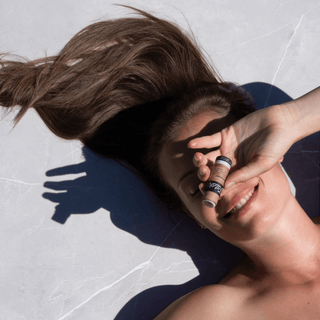We were never meant to live our lives under artificial lights, sprint outside at noon, and slather ourselves in SPF 50 as if the sun were a predator. But that’s what modern skincare advice tells us to do. At FATSKN, we think it’s time for a new kind of tanning guide—one based on biology, light timing, and trust in your skin.
Here’s how to tan the quantum way.
☀️ Step 1: Sunrise Is Your Skin's Pre-Tan Ritual
Before we talk about melanin, UVB, or even skincare, we have to talk about light timing. The very first light your eyes and skin see in the morning sets your body’s entire rhythm for the day. This morning signal:
-
Tells your brain to stop making melatonin (yes, the antioxidant your skin needs to repair)
-
Starts the countdown to when your skin will produce melanin
-
Preps your hormones and mitochondria for UV exposure later in the day
Without sunrise light, your body doesn't get the message. And a body that’s confused is one that burns easily.
🔑 Quantum tip: Spend 5–15 minutes outside within 30 minutes of waking—no glasses, no contacts, no windows.
🔅 Step 2: Earn Your Tan with UVA Light
UVA light rises before UVB. That’s nature’s way of preparing you. Exposure to UVA light in the morning (roughly 1–2 hours after sunrise) signals your skin to begin producing melanin, the pigment that naturally protects against UV damage and helps you tan instead of burn.
If you skip this and go straight to mid-day tanning? You’re playing catch-up—and your skin knows it.
🧬 Your melanin isn’t just for color—it’s a quantum molecule that helps your skin convert sunlight into energy.
🔥 Step 3: Embrace UVB—Gradually
By the time UVB arrives (usually 2–4 hours after sunrise), your skin should be primed. That means:
-
Melanin production is underway
-
Your antioxidant defenses are up
-
You’ve built up redox capacity through morning sun and movement
This is the part of the day when vitamin D is made and your skin can tan—if you’ve built up to it. Start small. 5 minutes. Then 10. Then 20. Learn your personal dose.
⚠️ Going from fluorescent lights to 30 minutes of UVB is not resilience—it’s recklessness. Skin needs context.
🧴 Step 4: Ditch the Sunscreen (and Know Why)
Most mainstream sunscreens are built to block UV, full stop. But what’s rarely discussed is:
-
They block vitamin D production
-
Many contain hormone-disrupting chemicals
-
They trap heat in your skin
-
They assume light is bad and you are fragile
At FATSKN, we don’t use sunscreen. Instead, we:
-
Expose skin consciously in the right light order
-
Build up gradually
-
Cover up with breathable linen or muslin when needed
-
Seek shade intuitively when our skin says “enough”
-
Eat a nourishing, antioxidant-rich diet to support skin from within
We don’t burn, because we don’t shock our system.
🌿 Step 5: Support Skin Before and After Sun
What you put on your skin does matter. Most commercial “aftersun” products are just aloe and preservatives. Instead, we recommend:
-
Red light therapy and magnesium (yep, we made a balm with both)
-
Whole-food fats like tallow and cacao butter to support barrier repair
-
Avoiding plant extracts or essential oils that might make skin more light-sensitive
And remember: Tanning isn’t bad. Burning is.
✨ The Takeaway: Your Skin Was Made for the Sun
You don’t need to fear the sun—you need to relearn how to meet it. That’s the heart of tanning the quantum way.
Your mitochondria are light-powered. Your hormones are light-timed. Your skin is light-responsive.
Trust it. Time it. And tan like your biology depends on it—because it does.
Related Reading:
📖 Why the Timing of Light Matters More Than Blue Light Itself
📖 The Spring Skin Reset
Disclaimer: This post is for informational and educational purposes only and does not constitute medical advice. Always consult a qualified healthcare provider before making changes to your sun exposure habits, skincare routine, or health protocols. FATSKN products are not intended to diagnose, treat, cure, or prevent any disease.
1. Circadian Rhythms & Skin Health
The circadian clock in skin: implications for UV-induced DNA damage repair
PMID: 22782540
“The skin possesses its own circadian rhythm which influences UV sensitivity and DNA repair capacity.”
2. UVA Induces Melanin Without Causing Burns
UVA-induced immediate pigment darkening: mechanism and significance
PMID: 11985741
“UVA induces immediate pigment darkening by oxidizing existing melanin precursors, providing a photoprotective effect.”
3. Sunscreen & Vitamin D Suppression
Sunscreens suppress cutaneous vitamin D3 synthesis
PMID: 28458711
“Proper sunscreen application almost completely blocks the production of vitamin D3 in the skin.”
4. Endocrine Disruption from Chemical Sunscreens
Sunscreens: UV filters with potential endocrine-disrupting properties
PMID: 27324353
“Common UV filters such as oxybenzone have been shown to have endocrine-disrupting potential in various models.”
5. Skin’s Role as a Neuroendocrine Organ Regulated by Light
The skin as a neuro-endocrine organ: implications for UV exposure
PMID: 15284391
“Skin acts as a neuro-endocrine organ capable of hormone production and phototransduction, heavily influenced by light exposure.”


